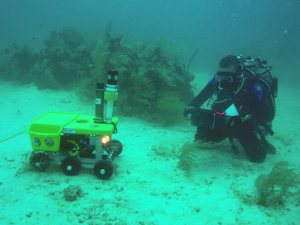
HAB.D | An Analogue for Space
“A” is for Analogue
Most of what happens on the Hab involves conducting ‘analogue missions’ that help astronauts train for their time on the International Space Station and future missions to asteroids, the moon, and even Mars.
 We’ve been calling the people training on the Aquarius Habitat “aquanauts,” and not just because it sounds cool. An aquanaut is a person who remains underwater long enough for their body to become saturated with the breathing gases, such as nitrogen. This is known as saturation diving.
We’ve been calling the people training on the Aquarius Habitat “aquanauts,” and not just because it sounds cool. An aquanaut is a person who remains underwater long enough for their body to become saturated with the breathing gases, such as nitrogen. This is known as saturation diving.
Since 2001, missions on the Aquarius last usually about two weeks, but can be as short as seven days or as long as three weeks. The goal: “To see what extreme environmental challenges astronauts may face in space, and to form solutions by using the ocean as an equivalent environment on earth.”
What exactly does “analogue mission” mean? An analogue mission is one that uses conditions and equipment that will simulate what astronauts will experience in space, whether it’s in the microgravity environment of the ISS, the one-third gravity of Mars, or the one-sixth gravity of the moon.
Extra Vehicular Activity
The main type of mission performed from down in the Hab is called an EVA, or Extra Vehicular Activity. In space travel, everything involves a lot of planning ahead of time: knowing what the mission is, how it’s going to be performed, the tools you need and how to use them, emergency procedures, deciding how long you’re going to be outside the vehicle, how you’re getting out and back in, etc. There is all sorts of important information you must know before you ever suit up.
They do the same thing on the Hab, because not only is it important to know what you’re doing before suiting up and going into the water, it’s also important to do things the exact same way that the astronauts will perform their tasks in space. That’s what makes the mission an analogue: creating an environment that approximates what they’ll do later on their actual missions.

For example, as aquanauts will test or make repairs to equipment outside the Hab, astronauts on the ISS have made repairs to the Hubble Telescope. Even though one experience is under water, and the other is in space, the same kinds of precautions are necessary.
Time Lag
Did you know that there is a time lag in communications across the great distances to the moon and Mars? Radio waves travel at the speed of light, which is about 1080 million kilometres per hour, or around 671 million miles per hour. That’s incredibly fast, but that means that when astronauts go to Mars, there will be a radio delay of anywhere from five to twenty-one minutes depending on where Mars is in its annual orbit of the sun. This is because Mars has an elliptical (sort of oval shaped) orbit of the sun, so sometimes it’s closer to Earth than other times of the year.
But if the aquanauts are directly outside the Hab, don’t they hear Mission Control straight away? There’s no huge distance there. That’s true, but as part of creating an analogue mission, communication to the aquanauts is deliberately delayed, simulating the distances between Earth and Mars. Authenticity is crucial.
Precision and accuracy are absolutely critical when you’re in space. Mistakes can be costly, to say the least. Training as thoroughly as possible helps insure the people who go into outer space can do their jobs and come home again safely.
Curriculum Reference Links
- Chemical World / Systems and Interactions / 7: Students should be able to investigate the effect of a number of variables on the rate of chemical reactions including the production
- Physical World / Systems and Interaction / 3: Students should be able to investigate patterns and relationships between physical observables




